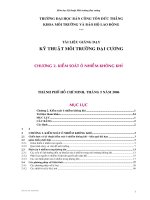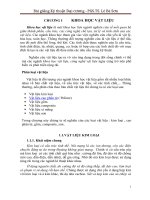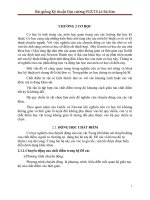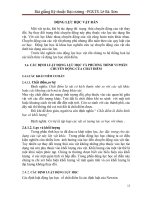DỊCH THUẬT ĐẠI CƯƠNG
Bạn đang xem bản rút gọn của tài liệu. Xem và tải ngay bản đầy đủ của tài liệu tại đây (501.28 KB, 8 trang )
<span class="text_page_counter">Trang 1</span><div class="page_container" data-page="1">
BỘ GIÁO DỤC VÀ ĐÀO TẠO
<b>TRƯỜNG ĐẠI HỌC CẦN THƠ </b>
<b>CỘNG HÒA XÃ HỘI CHỦ NGHĨA VIỆT NAM </b>
<b>Độc lập – Tự do – Hạnh Phúc </b>
<b>ĐỀ CƯƠNG CHI TIẾT HỌC PHẦN </b><b>1. Tên học phần: DỊCH THUẬT ĐẠI CƯƠNG - Mã số học phần: XH551 </b>
2.1.3a
<b>4.2 </b> Trình bày cơ bản về lịch sử nghiên cứu dịch thuật, các phẩm chất và đạo đức nghề nghiệp cần có của một phiên dịch viên, biên dịch viên. và cách dịch các đặc điểm ngữ pháp và các đặc điểm từ vựng.
2.1.3a
<b>4.3 </b>
Phát triển các kỹ năng học tập/tự học hiệu quả, giao tiếp hiệu quả, ý thức học tập nâng cao chuyên môn nghiệp vụ thường xuyên và ý thức trau đồi đạo đức nghề nghiệp biên/phiên dịch.
2.2.2a,b; 2.3a
<i><b>5. Chuẩn đầu ra của học phần: </b></i>
<b>CĐR </b>
<b>tiêu </b>
<b>CĐR CTĐT Kiến thức </b>
CO1 Định nghĩa dịch thuật là gì và thế nào là dịch theo nghĩa (meaning-based translation) so với dịch theo hình thức (form-based translation).
4.1 2.1.3a
CO2 Phân biệt các loại hình dịch thuật (literal translation, modified literal translation, idiomatic translation, and unduly free translation), các loại hình phiên dịch.
4.2 2.1.3a
CO3 Trình bày cơ bản về lịch sử nghiên cứu dịch thuật, các phẩm
chất và đạo đức nghề nghiệp cần có của một phiên dịch viên, <sup>4.3 </sup> <sup>2.1.3a </sup>
</div><span class="text_page_counter">Trang 2</span><div class="page_container" data-page="2"><b>CĐR </b>
<b>tiêu </b>
<b>CĐR CTĐT Kiến thức </b>
biên dịch viên. và cách dịch các đặc điểm ngữ pháp và các đặc điểm từ vựng.
<b>Kỹ năng </b>
CO4 Đọc và tóm tắt được các nội dung chính của tài liệu học tập về
CO5
Phát triển kỹ năng tìm kiếm thơng tin, kỹ năng làm việc nhóm, kỹ năng giao tiếp hiệu quả, kỹ năng làm việc độc lập, và kỹ năng học tập suốt đời.
4.3 2.3a
<b>6. Mơ tả tóm tắt nội dung học phần: </b>
Học phần Dịch thuật đại cương giới thiệu sơ lược về lịch sử nghiên cứu dịch thuật, các định nghĩa dịch thuật, các loại hình dịch thuật, sự khác biệt của dịch theo nghĩa và dịch theo hình thức, cách dịch các đặc điểm ngữ pháp và từ vựng, và các phẩm chất, đạo đức nghề nghiệp cần có của biên dịch/phiên dịch viên. Học phần cũng cung cấp một vài bài tập thực hành giúp sinh viên rèn luyện kỹ thuật biên dịch và phiên dịch Anh-Việt, Việt-Anh, qua đó hiểu rõ tầm quan trọng việc không ngừng nâng cao chuyên môn nghiệp vụ và phẩm chất, đạo đức nghề nghiệp của người biên dịch/phiên dịch.
<b>7. Cấu trúc nội dung học phần: 7.1. Lý thuyết </b>
Lesson 1 What is translation? What is based translation vs form based translation?
<b>Lesson 2 Kinds of Translation & Interpreting </b> <sub>6 </sub> <sub>CO1 </sub>
Lesson 3 Translating grammatical features and lexical features
3 <sub>CO2, CO3 </sub>Lesson 4 Codes of Ethics for Translators and
<b>9. Nhiệm vụ của sinh viên: </b>
Sinh viên phải thực hiện các nhiệm vụ như sau:
</div><span class="text_page_counter">Trang 3</span><div class="page_container" data-page="3">-Tham dự tối thiểu 80% số tiết học lý thuyết. -Tuân thủ các nội quy của lớp học phần
-Thực hiện đầy đủ các bài tập cá nhân/nhóm và được đánh giá kết quả thực hiện. -Tham dự kiểm tra giữa học kỳ.
Đi học đầy đủ, đúng giờ; tích cực tham gia phát biểu xây dựng bài; tích cực làm việc đơi/nhóm
- Tham dự đủ 80% tiết lý thuyết - Thi trắc nghiệm (80 phút) - Bắt buộc dự thi
50% CO1, CO3, CO5
<b>11. Tài liệu học tập: </b>
<b>biệt </b>
Tài liệu bắt buộc:
[1] Larson, M.L. (1998). Meaning-Based Translation: A Guide to
<i>Cross-Language Equivalence. 2nd edition. New York: University Press of </i>
America.
[2] Munday, J. (2016). Intruducing Translation Studies: Theories and
<i>Applications. 4</i><sup>th</sup> edition. Routledge.
<i>[3] Nguyễn Quốc Hùng (2007). Hướng dẫn kỹ thuật Phiên dịch </i>
<i>Anh-Việt, Việt-Anh. NXB Tổng hợp TPHCM. </i>
Tài liệu xem thêm:
<i>[4] Nguyễn Quốc Hùng (2007). Hướng dẫn kỹ thuật Biên dịch </i>
<i>Anh-Việt, Việt-Anh. NXB Văn hóa Sài gịn. </i>
<b>12. Hướng dẫn sinh viên tự học: </b>
</div><span class="text_page_counter">Trang 4</span><div class="page_container" data-page="4"><b>lý thuyết </b>
<b>tiết thực hành </b>
<b>của sinh viên </b>
Session 1 What is translation? What is meaning-based
translation vs form based translation? <sup>3 </sup>
<small>Đọc trước tài liệu [1] </small>
<b><small>Chapter 1 </small></b>
<small>tài liệu [1] Chapter 2 </small>
<small>tài liệu [3] </small>
Session 4 Translating grammatical and lexical features
2 <sub>1 </sub> <small>Đọc trước tài liệu [1] Chapter 2 </small>
Session 5 Code of Ethics for Translators and Interpreters
3 <small>Đọc trước tài liệu [3] </small>
Session 6 Code of Ethics for Translators and Interpreters (con’t)
3 <small>Đọc trước tài liệu [3] </small>
Session 8 Main Issues of Translation Studies 3 <small>Đọc trước tài liệu [2] Chapter 1 </small>
Session 9 Main Issues of Translation Studies 3 <small>Đọc trước tài liệu [2] Chapter 1 </small>
Session 10 Translation Theory before the Twentieth Century
3 <small>Đọc trước tài liệu [2] Chapter 2 </small>
Session 11 Translation Theory before the Twentieth Century
3 <small>Đọc trước tài liệu [2] Chapter 2 </small>
Session 12 Equivalence and Equivalent Effect 3 <small>Đọc trước tài liệu [2] Chapter 3 </small>
Session 13 Studying Translation Product and Process 3 <small>Đọc trước tài liệu [2] Chapter 4 </small>
Session 14 Functional Theory of Translation 3 <small>Đọc trước tài liệu [2] Chapter 5 </small>
Session 16 Final Exam
</div><span class="text_page_counter">Trang 5</span><div class="page_container" data-page="5"><small>MINISTRY OF EDUCATION AND TRAINING </small>
<b>CAN THO UNIVERSITY </b>
<b>SOCIALIST REPUBLIC OF VIETNAM Independence-Freedom-Happiness </b>
<b>COURSE SYLLABUS </b>
<b>1. COURSE INFORMATION </b><b>- COURSE TITLE: INTRODUCTION TO TRANSLATION STUDIES - COURSE NAME: XH551 </b>
<b>- COURSE CREDITS: 03 credits </b>
-<b> COURSE LENGTH: </b> 43 lecture hours, 02 practice hours, 90 self-study hours
<b>2. COURSE MANAGEMENT UNITS : </b>
<b>- SCHOOL: </b> School of Foreign Languages
<b>- DEPARTMENT: </b> English Language and Culture
<b>3. PREREQUISITE: None </b>
<b>4. COURSE OBJECTIVES: The course is aimed to help students to: </b>
<b>4.1 </b>
Discuss definitions of translation and the differences between meaning-based translation and form-based translation. Differentiate between four kinds of translation, namely literal translation, modified literal translation, idiomatic translation, and unduly free translation) to see that the goal of a translator is to produce an idimatic translation. Discuss different types of interpreting to see that for each of the types, the interpreter has to adopt a respective role to do a good job of interpreting.
2.1.3a
<b>4.2 </b> <sup>Discuss briefly the history of Translation Studies, qualifications </sup><sub>and codes of ethics required of a translator/interpreter and how to </sub>
translate grammatical and lexical features.
2.1.3a
<b>4.3 </b>
Develop effective learning skills and a sense of continuing professional development for the translating/interpreting career and codes of ethics if they want to become translators/interpreters.
2.1.3a
<i><b>5. Chuẩn đầu ra của học phần: At the end of the course, students will be able to: </b></i>
<b>Knowledge </b>
CO1 <sup>Define what translation is and distinguish meaning-based </sup>
translationa from form-based translation. <sup>4.1 </sup> <sup>2.1.3a </sup>CO2 <sup>Compare four kinds of translation (literal translation, </sup><sub>modified literal translation, idiomatic translation, and </sub>
unduly free translation), and different types of interpreting.
4.1 2.1.3a
</div><span class="text_page_counter">Trang 6</span><div class="page_container" data-page="6"><b>COs Contents Objectives POs Knowledge </b>
CO3
Discuss briefly the history of Translation Studies, qualifications and codes of ethics that a translator/interpreter need to have and how to translate grammatical and lexical features.
4.3 2.3a
<b>6. Course Description: </b>
The course Introduction to Translation Studies is two fold. First, it discusses definitions of translation, meaning-based translation vs form-based translation, kinds of translation, some techniques to translate grammatical and lexical features, and codes of ethics for translators and interpreters. Then, it introduces the history of Translation Studies as a discipline. The course also provides students with some practical translation exercises to help them better realize the need to make a lot of adjustments in form in translation while keeping the meaning unchanged so as to have a translation that is idiomatic in the target language and the need to follow professional ethics of a translator.
<b>7. Course Structure: 7.1. Theory </b>
<b>Lesson 2 Kinds of Translation & Interpreting </b> <sub>6 </sub> <sub>CO2 </sub>
Lesson 3 Translating grammatical features and lexical features 2 <sub>CO3 </sub>Lesson 4 Code of Ethics for Translators and Interpreters 4 <sub>CO3 </sub>
Students are expected to:
- Attend at least 80% of the lecture hours
- Attend 100% practice hours and have a result report - Complete all the required assignments
- Attend mid-term and final exams
</div><span class="text_page_counter">Trang 7</span><div class="page_container" data-page="7">- Be responsible for self-study hours.
<b>10. Evaluation: 10.1. Evaluation </b>
1 Attendance Regular attendance (at least 80% of class sessions), active participation
<b>11. Teaching Materials: </b>
<b>cá biệt </b>
Required:
[1] Larson, M.L. (1998). Meaning-Based Translation: A Guide to Cross
<i>Language Equivalence. 2nd edition. New York: University Press of </i>
America.
[2] Munday, J. (2016). Intruducing Translation Studies: Theories and
<i>Applications. 4</i><sup>th</sup> edition. Routledge.
<i>[3] Nguyễn Quốc Hùng (2007). Hướng dẫn kỹ thuật Phiên dịch </i>
<i>Anh-Việt, Việt-Anh. NXB Tổng hợp TPHCM. </i>
Suggested:
<i>[4] Nguyễn Quốc Hùng (2007). Hướng dẫn kỹ thuật Biên dịch </i>
<i>Anh-Việt, Việt-Anh. NXB Văn hóa Sài gịn. </i>
<b>12. Hướng dẫn sinh viên tự học: </b>
<b>lý thuyết </b>
<b>Số tiết thực hành </b>
<b>Nhiệm vụ của sinh viên </b>
Session 1 What is translation? What is meaning-based translation vs form based translation?
</div><span class="text_page_counter">Trang 8</span><div class="page_container" data-page="8">Session 4 Translating grammatical and lexical features
Chapter 2 Session 5 Code of Ethics for Translators and
Session 8 Main Issues of Translation Studies 2 Read [2] Chapter 1 Session 9 Main Issues of Translation Studies 2 Read [2]
Chapter 1 Session 10 Translation Theory before the Twentieth
Century
Chapter 2 Session 11 Translation Theory before the Twentieth
Century
Chapter 2 Session 12 Equivalence and Equivalent Effect 3 Read [2]
Chapter 3 Session 13 Studying Translation Product and Process 3 Read [2]
Chapter 4 Session 14 Functional Theory of Translation 3 Read [2]
Chapter 5
Session 16 Final Exam
</div>








